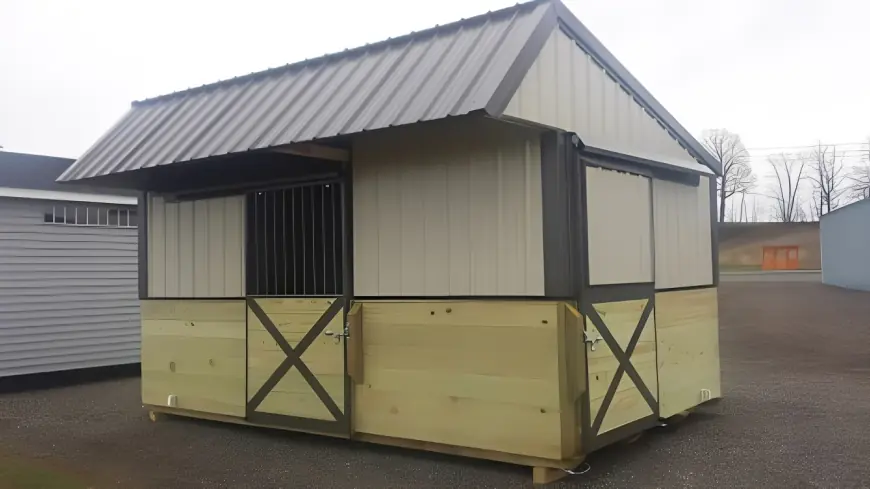Mistakes That Shorten the Lifespan of Animal Shelter Sheds

Animal shelter sheds in Mequon play a crucial role in providing safe, clean, and comfortable housing for animals. However, many shelters unintentionally make common mistakes that reduce the lifespan of their sheds. These mistakes can lead to early damage, costly repairs, and unsafe conditions for animals. Understanding these issues can help you avoid them and keep your shelter sheds strong and long-lasting.
1. Poor Foundation Planning
Every animal shelter shed needs a solid and level foundation. Skipping this step or choosing the wrong base material can lead to moisture issues, uneven floors, and even structural cracks.
Common foundation issues include:
-
Building directly on soil without gravel or concrete
-
Ignoring drainage requirements
-
Using low-quality foundation materials
Always plan the base properly. A stable and well-drained foundation helps prevent water damage and keeps the structure sturdy for years.
2. Inadequate Ventilation and Insulation
Sheds without proper ventilation can become hot, stuffy, and full of unpleasant odors. Poor airflow causes condensation, which leads to mold, mildew, and rust.
Common mistakes include:
-
Not installing vents or windows
-
Ignoring insulation for temperature control
-
Blocking natural airflow with stored items
Make sure your animal shelter shed has proper air circulation and insulation to keep animals comfortable and your structure safe from internal damage.
3. Skipping Regular Cleaning and Maintenance
Like any building, an animal shelter shed needs regular cleaning and care. Neglecting this can lead to rapid wear and tear.
Maintenance tasks to prioritize:
-
Cleaning animal waste and debris daily
-
Checking for leaks, rust, or mold monthly
-
Repainting or sealing wood annually
-
Replacing damaged parts on time
Avoiding these small tasks can cause long-term issues that are expensive to fix and harmful for animals.
4. Using Low-Quality Materials
Trying to save money by using cheap materials can result in frequent repairs and early replacements. Low-quality wood or metal is more likely to rot, rust, or warp.
What to avoid:
-
Thin untreated wood
-
Non-galvanized metal
-
Low-grade plastic panels
Invest in durable, weather-resistant materials that can handle rain, snow, and animal activity without falling apart quickly.
5. Overcrowding the Shed
Squeezing too many animals or supplies into a small space can damage the structure. Floors and walls can weaken from constant pressure or scratching.
Signs of overcrowding include:
-
Chewed or scratched walls
-
Cracked floors from weight stress
-
Limited space for animals to move
Respect the size limit of your shed. Every animal needs space to rest and move freely without overloading the structure.
6. Ignoring Pest Control
Pests like termites, rats, and ants can damage the shed structure and make animals uncomfortable. Ignoring pest control can lead to infestation and structural rot.
Prevention tips:
-
Seal all small openings
-
Use pest-repellent sprays safely
-
Keep surroundings clean and dry
A simple monthly inspection can help you detect pest problems early before they cause big damage.
7. Not Preparing for Local Weather
Every region has different weather conditions, and your animal shelter shed should be built to handle them. Not preparing for extreme temperatures, rain, or snow can shorten your shed’s life.
Weatherproofing steps:
-
Add waterproof coating on walls and roofs
-
Use sloped roofing for snow and water runoff
-
Install gutter systems for drainage
Adapt your shed based on local weather to prevent common damage caused by natural elements.
Let's Rewind:
Avoiding these common mistakes can greatly increase the life of your animal shelter shed in Wisconsin. Whether it’s building on the right foundation or using quality materials, small decisions can make a big difference in the long-term safety and stability of your shelter.
What's Your Reaction?
 Like
0
Like
0
 Dislike
0
Dislike
0
 Love
0
Love
0
 Funny
0
Funny
0
 Angry
0
Angry
0
 Sad
0
Sad
0
 Wow
0
Wow
0
















































